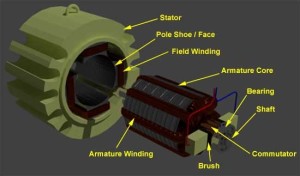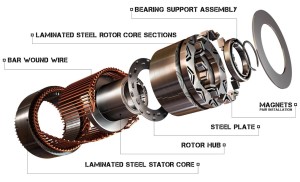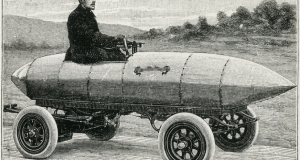AUTHOR: AMIT JHA
From my previous blog I hope now we are clear on what we should expect from the motor and what we should aim for when designing the motor. The Demeter programme focuses on the design of the PM motor for the automobile application.
So, let’s discuss some of the motors and their properties.
DC motor: The DC motor is the most widely used motor in railway traction for over 100 years. As name suggest the motor is supplied using direct current power source. There are four kinds of DC motors
1) Series wound
2) Shunt wound
3) Compound wound
4) Separately excited
The easy construction, operation, and control of DC motors are the biggest advantages. The DC series motor is best suited for traction application due to its very high starting torque. The DC motor like Induction or Permanent Magnet motor has coils in the stator; however, the major design differs in rotor construction. From Figure 1 it can be seen that the rotor also has coils, which is used to create electromagnet in the rotor. As the rotor is rotating, it needs a special arrangement to supply power to the rotor called commutator. In addition carbon brushes are required to connect power cables and commutator. The DC motor gives a greater control to the stator and the rotor flux, which in turn, makes control of these motors very easy and low cost. In the separately excited motor, the stator flux and rotor flux can be controlled independently as per torque speed requirement.
On the other hand, the commutator and carbon brushes in the rotor require high maintenance. The brushes attached to the commutator cause sparks during operation which cause high wear and tear in the motor. Due to high copper loss both in stator and rotor the motor has poor efficiency. The efficiency is further reduced due to commutation process. The efficiency of its controller is also low.
Figure 1: DC motor components [http://www.electrical4u.com/]
AC motors: The alternating current ( AC) power motors gained popularity with the development of the variable frequency drive in 1980’s that made variable speed torque operation of AC motors feasible [1].
AC motors can be classified in two categories
- a) Asynchronous motor e.g. Induction motor
- b) Synchronous motor e.g. PM motors, Reluctance motor
At present both Induction motor and PM motors are used widely for traction application. The presence of Induction motors in Metros/city transports/underground rails and locomotives is higher than that of PM motors and the main reason is simply due to the lower cost of the system using Induction motor. Also, customers sometimes want Induction motor drive systems as it is a proven system and less risk is involved. The PM motors are widely used in automobile companies such as Toyota, BMW, etc. However, there are some manufactures like TESLA, General Motors, and Ford who have used induction motor in their cars.
Below are brief descriptions of the Induction and the PM motor.
Induction motor: The induction motor is considered the most reliable and cost effective motor production volume wise. It is the most commonly used motor in all industries. Figure 2 shows a cut section of the induction motor. The stator has copper coils and is similar to the stator used for DC motors or PM motors. The major difference is the rotor which is made up of aluminum. The rotor bars can also be made up of copper. The aluminum/copper bars in the rotor of induction motor is also called squirrel cage.
As we know, to generate torque a machine needs two interacting fluxes. In a motor, one comes from stator called stator flux and the other is from rotor called rotor flux. In an Induction motor, according to Faraday’s and Lenz’s laws, the rotor flux is generated because of the rotating flux from stator and then both the fluxes interact and produce torque. Therefore, like the DC motor, in an induction motor there is no need of an external arrangement to energize its rotor – this makes both manufacturing and operation simpler. The motor can operate directly online or with variable frequency drive. The control of an induction motor is very simple to implement.
Figure 2: Cut section of an Induction motor [https://en.wikipedia.org/wiki/Induction_motor]
The efficiency of the motor and drive is also higher than that of the DC motor. Due to its simple design, the motor does not require high maintenance. The rotor is also very robust. However, at very high speed mechanical stability of the aluminum rotor bars must be considered. Induction motors have been present on the market since long ago and the manufacturing process has been optimized which makes this motor very competitive with respect to cost
PM motors: There are many different types of synchronous motors like the PM motor, Switched Reluctance motor, Reluctance motor, etc. Figure 3 shows the cross section of the different motors. All these motors are called synchronous motors because unlike induction motors these motors can run only at a synchronous speed (i.e. at same frequency as the supply frequency). Another interesting thing to notice here is that all motors can use the same stator but the construction of rotor is different. Sync Reluctance motor and Inset PM motor rotor look very similar. The only difference is that with inset PM motors the flux barriers are filled with PMs.
Figure 3: Cross section of different types of Synchronous motor
Well here in this blog the objective is to discuss and describe PM motor only, as other motors are not used for traction as yet. But in my opinion they have high potential to be used for this application.
With the development of high power magnets around the 1980’s, the PM motors also became very competitive for different applications. Their construction in simple terms can be seen similar to the DC motor where the rotor coils are replaced with highly energized magnets (see Figure 4). The stator coils when supplied with 3 phase AC supply produce a rotating flux. The flux from magnets in the rotor interacts with the stator flux and produces torque. Like in DC motors, the rotor flux in PM motors cannot be controlled and has impacts on the design of the motor.
The motor has many advantages over Induction or DC motors.
- High torque and power density: It makes the motor very useful for automobile applications where space is a big constraint.
- The efficiency of the motor: Higher efficiency results in saving battery power or energy rendering electric cars environment friendly. Also, it saves energy required for cooling due to less heat loss in the motor.
- Compact and low weight: Low weight in turn results in saving fuel/energy.
- High Torque at low speed: Higher torque at low speed is required to have higher acceleration and PM motor produces higher torque compared to IM motors.
 Figure 4: Construction of inset magnet PM motors [http://elect-eng-world1.blogspot.fr/]
Figure 4: Construction of inset magnet PM motors [http://elect-eng-world1.blogspot.fr/]
The presence of magnets allows for a complex design however, with complex design the manufacturing cost also increases and also recycling would be difficult. Hence, in Demeter programme as motor designer one of the aim is to consider the design complexity.it means – recycling would be very difficult. Furthermore, PM motors require special tools for its maintenance. Therefore, these motors also bring challenges in terms of economically recycling and repairing.
The performance of the motor largely depends on the quality of the magnets used. The high performance motors use rare earth magnets like SmCo and NdFeB which are expensive and increase the cost of motors. Some low cost PM motors use Ferrite but there is always a risk of demagnetization of magnets. PM motors are also very sensitive to temperature.
The drives/controller of these motors is expensive and the control strategy is also complex compared to induction motor drive. To maximize the performance of the motor, an external sensor–called resolver–is required to be attached to the rotor shaft to sense the position of the rotor.
Other than high motor cost and maintenance cost, PM motor technology has many challenges and its use increases the cost of the system. Some are mentioned below:
- In case of any fault in converter, a special arrangement has to be made for PM motor to completely cut off from the system. Because post fault the vehicle continues to run and the PM machine starts working like a generator due to highly magnetized magnets.
- The short circuit (SC) in PM motor can damage magnets in the motor or the converter, depending on the short circuit location. Therefore, extra precaution must be taken.
- SC torque of PM motor compared to induction motor is higher and hence, not good for the mechanical system – especially gearbox.
- For PM motor drive, each motor requires one separate inverter to control, whereas in case of induction motor the same drive can be used to control 2 or more motors.
Table 1 shows a summary of comparison between Induction, DC and PM motor. The comparison is made on very general level. It’s very hard to choose between Induction and PM motor drive system taking all factors into consideration. One has to be very careful while choosing the type of motor as the selection depends on many factors like required load profile, operating temperature, type of application and most importantly: the cost. Sometimes the customer also has very specific requirements on efficiency, noise, or one particular type of motor, etc.
Table 1: Comparison between Induction, DC and PM motor [2], [1], [3]
The performance of the motor depends on the interface between its drive and the mechanical system. It is relatively easy to design a very good motor but it takes a lot of effort to make a very efficient, cost effective, and reliable drive system one and designing motor for the system is very complex process. Therefore, while selecting/designing an electric motor it is imperative to take on a holistic perspective rather than just focusing on only the motor.
Bibliography
| [1] | R.J.Hill, “DC and AC Traction Motors,”. |
| [2] | Narayan C.Kar Gaurav Nanda, “A survery and comparison of characteristics of motor drive used in Electric Vehicles,” IEEE. |
| [3] | L. Chang, “Comparison of AC drives for Electric Vehicles-A report on Expert’s opinion Survey,” IEEE, 1994. |
| [4] | Tom Randall. (2016, Feb) Bloomberg. [Online]. http://www.bloomberg.com/features/2016-ev-oil-crisis/ |

 European Training Network for the Design and Recycling of Rare-Earth Permanent Magnet Motors and Generators in Hybrid and Full Electric Vehicles (DEMETER)
European Training Network for the Design and Recycling of Rare-Earth Permanent Magnet Motors and Generators in Hybrid and Full Electric Vehicles (DEMETER)




